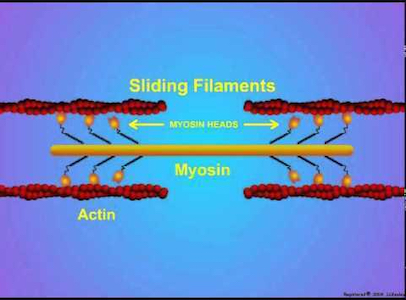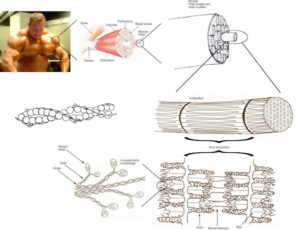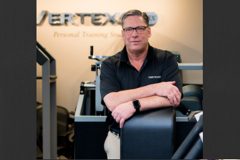Sliding Filament Theory – Why You’re Stronger Lowering a Weight Than Lifting It
It’s easy to instinctually understand that lowering a weight is easier than lifting it–but why? You might assume that it’s because “gravity is helping you”, but that’s not accurate–gravity is actually the force pulling against your contraction when you lift or lower the weight. The only way for gravity to “help” would be to drop the weight completely and let it fall to the floor. Gravity exerts the same force on your weight when you lift and when you lower, so why does it feel easier when you lower it? The answer may be in Sliding Filament Theory.
What is a Filament?
To understand what sliding filament theory is, you first have to understand what a filament is, and how your muscle generates a contraction. A “filament” is part of what makes up your muscle fiber. Your entire muscle is made up of about 80% water and about 20% protein filaments. These filaments can slide together, and they can slide apart–that’s what allows your muscle to move, with this contracting and relaxing motion.
According to Wayne Westcott PhD in “Building Strength and Stamina”, “A muscle is composed of cylindrical fibers that are responsible for force production. Each fiber consists of thick protein filaments called myosin and thin protein filaments called actin. The myosin and actin protein filaments are loosely coupled by means of tiny cross-bridges. Although the exact mechanism for muscle enlargement is not fully understood, it is believed that progressive strength exercise increases the number or size of the protein filaments, increasing the size of each muscle fiber.”
What is Sliding Filament Theory? 
To visualize your muscles, think of a thick phone cable with many smaller cables wrapped within it. When your muscle contracts, the fibers inside either bunch up and slide together, or relax and stretch out, sliding apart.
Matt Brzycki in his book “A Practical Approach to Strength Training, 4th Edition” describes the mechanics of sliding filament theory: “As the name of this theory implies, one set of protein filaments is thought to slide over the other and overlap (like pistons in a sleeve,) thereby shortening the muscle. Here’s how: The myosin filaments have tiny protein projections int eh shape of globular heads that extend toward the actin filaments. During a concentric contraction, it’s believed that these projections (or cross-bridges) bind to the actin filaments and then swivel in a ratchet-like fashion–much like oars in a boat–in such a way that it pulls the actin filaments over the myosin filaments. The cross-bridges then uncouple from the actin filaments, pivot, reattach and repeat the cycle. Thus, the process can be summed up as attach-rotate-detach-rotate.”
Concentric vs. Eccentric Contractions
So, what does this mean in terms of your workout? When you lift and lower a weight (not necessarily lifting and lowering a limb, just lifting and lowering a weight stack,) you perform both concentric and eccentric contractions. A concentric contraction happens when you lift a weight stack, and your muscle fibers contract and slide together. An eccentric contraction happens when you lower the weight by causing your muscle fibers to slide apart. Each individual muscle fiber cannot produce more or less force, they can only contract or relax at 100%. You generate more or less force by engaging more or fewer muscle fibers. When you lift a weight stack of, say, 100 pounds, you must generate more than 100 pounds of force in order to overcome the resistance provided by gravity as well as the resistance provided by the friction in your muscle fibers. When you lift the weight, that friction fights against you. But when you lower the weight and perform an eccentric contraction, that friction helps to slow the contraction down and it helps you perform the work. You are able to perform more work during an eccentric contraction–about 40% more. In other words, you can lower 40% more weight than you are capable of lifting. (This is the principe behind the Negative Only rep technique.)
To learn more about sliding filament theory and how the HIT method uses this theory to inform strength training principals, talk to a trainer at Vertex Fitness.
Request a complimentary first session at Vertex Fitness, Voted the BEST Personal Training Studio on the Main Line
Click HERE and we will schedule a session to try it yourself
Complimentary First Workout Session









Leave a Comment